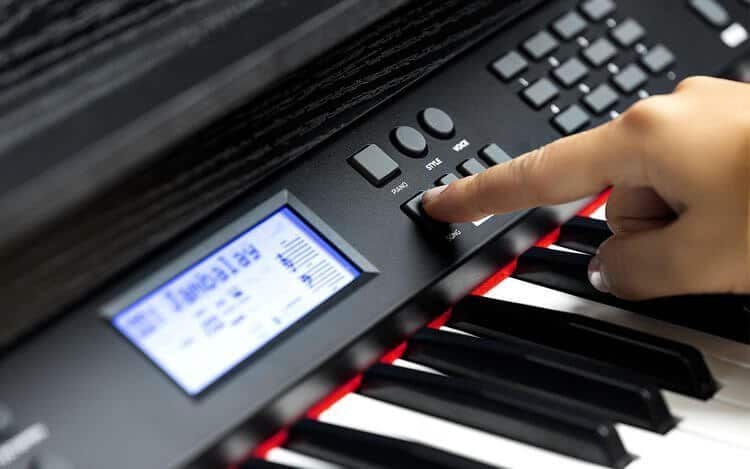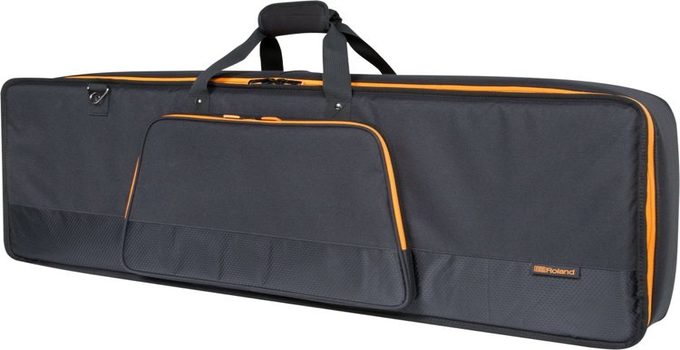*Keyboardkraze now has a nearly 24/7 chat service directly with me should you have any questions regarding keyboard/plugin choices! This is connected directly to me and it is not AI.
Table of Contents
The Yamaha P-45 has been one of the best options for its price point for years. I’ve had the pleasure of owning and playing this for about four years. This is also one of the keyboards I would use for demos for Vinyl Theatre.
In this article, I will summarize my thoughts and a full review of the P-45 while providing you with a few other choices.
The Yamaha P-45 is one of the main keyboards I recommend for kids. It has 88 fully-weighted keys and a solid piano sound. This not only gets your foot in the door, but also gives you an option that you won't outgrow for years.
Pros
- Compact
- One of the best choices for beginners
- Ten different sounds
- 88 fully weighted keys
- Easy to navigate and use
- Inexpensive
Cons
- Speakers aren’t the most powerful
- No recording function
Specs

- AWM stereo sampling
- 88 weighted keys
- 64 note polyphony
- Power supply included
- Speakers: 2 x 4.5woofers
- Amplifiers: 2X6W
Yamaha P-45 Overview
The P-45 has remained a front-runner for digital pianos near $500. For this review, I have compared it against some of the most popular options in 2023.
*I have over three years of experience playing the P-45, so this review is transparent and my actual thoughts.
The P-45 is so popular because it gives beginners an honest look at a cheap digital piano yet has everything you need to get started.
While the P-45 likely won’t “wow” an advanced pianist, it will for sure impress those who are just getting into playing digital pianos.
The P-45 has 88 keys, each individually sampled to capture the unique tonal characteristics of a grand piano. This means that when you play the P-45, you will hear a rich and expressive piano sound that is faithful to the original instrument.
Fun fact: I used the P-45 when recording the demo for this Vinyl Theatre song here:
P-45 Design

The P-45 has a sleek and modern design, with a clean and simple control panel that makes it easy to navigate and use. If you’re familiar with Yamaha, you will remember that the P-45 is the successor to the P-35, which was very similar design-wise.
The P-45 is 52.2 inches wide, 6 inches high, and 11.6 deep. It comes at a slim 25 lbs, perfect if you need portability.
Keys
The keys are weighted and feel like a real piano, allowing you to control the dynamics of your playing and create more expressive performances. The keys are comparable to any other option near its price point, such as the B-2 by Korg; however, I would take the FP-10 keys over the P-45.
The action itself is spot-on and a little on the lighter side IMO.
Sounds
The P-45 only comes with ten sounds, with two being piano sounds and the rest being various sounds such as electric piano and bass guitar.
The stock piano sound is quite good. For the price point, it’s tough to beat this stock piano.
Speakers
The speakers are plenty for those looking to practice. If you want to play gigs, plug into the PA or an amplifier.
The P45 features 2 x 12 cm built-in speakers (6W + 6W amp. They’re not super powerful, but as stated above, they are plenty loud for practice.
P-45 VS Korg B-2
The Yamaha P-45 and the Korg B-2 are digital pianos for beginner to intermediate-level players. Both instruments are compact and portable, making them an excellent choice for musicians looking for a portable piano they can take with them on the go. First, let’s take a look at some key differences.
One of the main differences between the P-45 and the B-2 is their sound quality. The P-45 is equipped with Yamaha’s Pure CF Sound Engine, which is designed to deliver a realistic and authentic piano sound. The B-2 is equipped with Korg’s MFB Technology, which is also designed to provide a natural and authentic piano sound. Both sound engines are highly respected in the industry and are known for their ability to deliver high-quality piano sounds.
Another key difference between the P-45 and the B-2 is their touch sensitivity. The P-45 has a Graded Hammer Standard (GHS) keyboard, which is designed to feel like a real piano. The B-2 has a Natural Weighted Hammer Action (NH) keyboard, which is also designed to feel like a real piano. Both keyboards are weighted, which allows you to control the dynamics of your playing and create more expressive performances.
In terms of connectivity, both the P-45 and the B-2 have a range of different options. They both have a USB port, which allows you to connect them to a computer and use them as a MIDI controller. They also both have a line out, which allows you to connect them to an external amplifier or sound system. Finally, they both have a headphone jack, which is great for practicing quietly or for recording yourself.
The Yamaha P-45 and the Korg B-2 are excellent digital pianos for beginner to intermediate-level players. They both have high-quality sounds and responsive touch sensitivity and are compact and portable, making them an excellent choice for musicians on the go.
My Choice: I would personally choose the P-45 over the Korg-B2. I like the B2; the P-45 has more admirable action and sounds IMO.
Who Is The P-45 For?
The Roland P-45 is a digital piano that is designed for beginner to intermediate-level players. It is a compact and lightweight instrument, making it an excellent choice for musicians looking for a portable piano they can take on the go.
P-45 VS Roland FP-10
The P-45 and the FP-10 are two of the most popular digital pianos near their price points. Up until recently, the P-45 ruled the market for options near $500.
The Yamaha P-45 and the Roland FP-10 are digital pianos designed for beginner to intermediate-level players. In addition, both instruments are compact and portable, making them an excellent choice for musicians looking for a portable piano they can take with them on the go.
One of the main differences between the P-45 and the FP-10 is their sound quality. The P-45 is equipped with Yamaha’s Pure CF Sound Engine, which is designed to deliver a realistic and authentic piano sound. The FP-10, on the other hand, is equipped with Roland’s SuperNATURAL sound engine, which is also designed to deliver a realistic and authentic piano sound. Both sound engines are highly respected in the industry and are known for their ability to deliver high-quality piano sounds.
Another key difference between the P-45 and the FP-10 is their touch sensitivity. The P-45 has a Graded Hammer Standard (GHS) keyboard, which is designed to feel like a real piano. The FP-10 has a Progressive Hammer Action (PHA) keyboard, which is also designed to feel like a real piano.
The FP-10 plays better, but the P-45 is a close second for this price point.
In terms of connectivity, both the P-45 and the FP-10 have a range of different options. They both have a USB port, which allows you to connect them to a computer and use them as a MIDI controller. They also have a line out, enabling you to connect them to an external amplifier or sound system. Finally, they both have a headphone jack, which is excellent for practicing quietly or recording yourself.
The Yamaha P-45 and the Roland FP-10 are excellent digital pianos for beginner to intermediate-level players. They both have high-quality sounds and responsive touch sensitivity and are compact and portable, making them a perfect choice for musicians on the go. Ultimately, the decision between the two will come down to personal preference and which features are most important to you.
My Choice: After years of playing both, I would choose the Roland FP-10 over the P-45.
P-45 VS P-125A
The Yamaha P-125A and the P-45 target similar prices-points, with the P-125A being one of Yamaha’s newest additions. In addition, both instruments are compact and portable, making them a great choice for musicians who are looking for a portable piano that they can take with them on the go. In this comparison, we will take a look at the key differences between the P-125A and the P-45 and discuss their pros and cons.
One of the main differences between the P-125 and the P-45 is their sound quality. The P-125A is equipped with Yamaha’s Pure CF Sound Engine, which is designed to deliver a realistic and authentic piano sound. The P-45 is also equipped with the Pure CF Sound Engine, but the P-125 has a more powerful version of the sound engine, which is designed to deliver an even richer and more expressive piano sound.
Also, the P-125A has 192-note polyphony, while the P-45’s drawback is that it only has 64-note polyphony.
My Choice: The P-125A is a higher quality keyboard than the P-45, so I would choose that.
Overall
The Yamaha P-45 remains one of the top choices for options near the $500 price point. From a solid key bed, reliability, portability, and impressive sounds, it’s hard to go wrong with the P-45.








